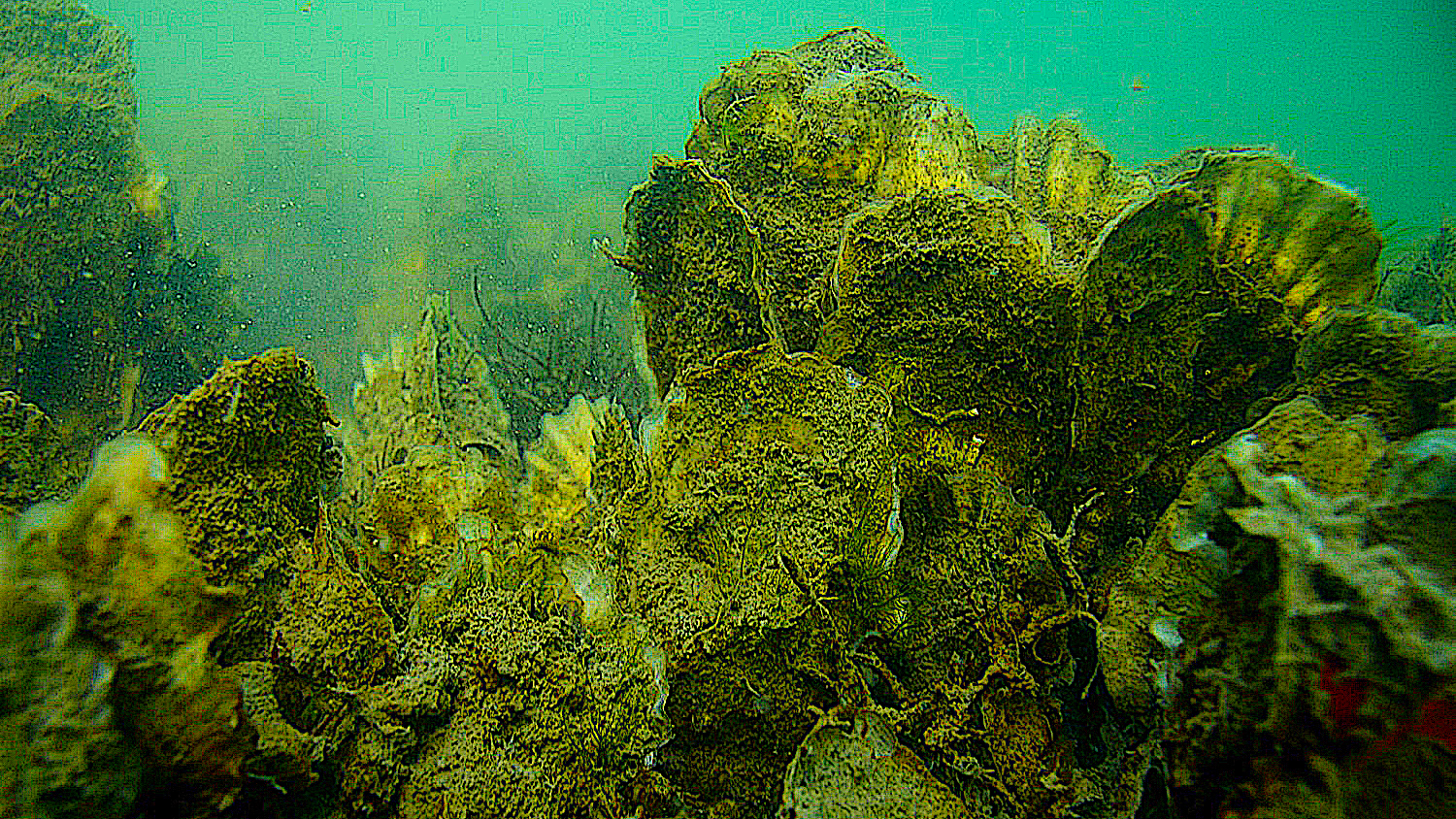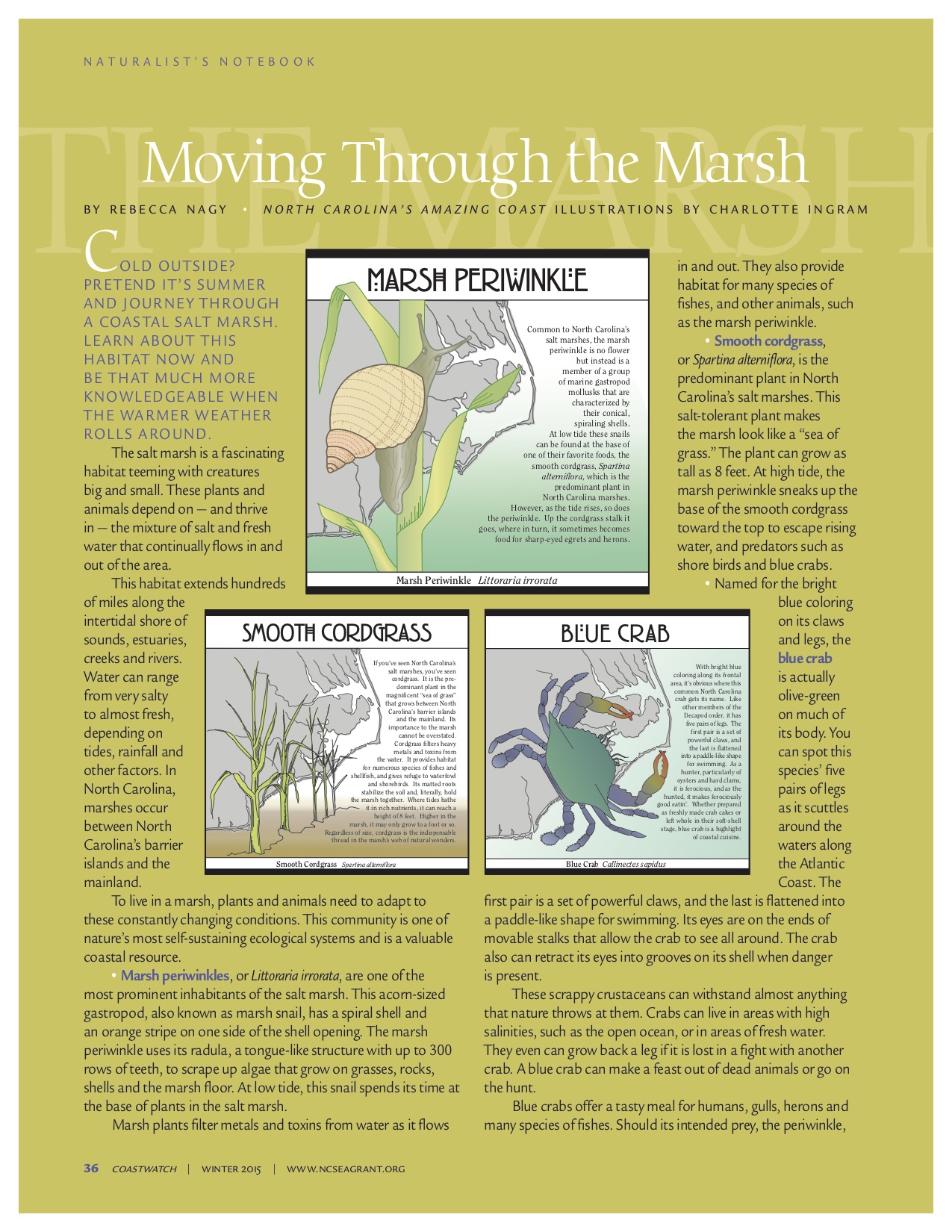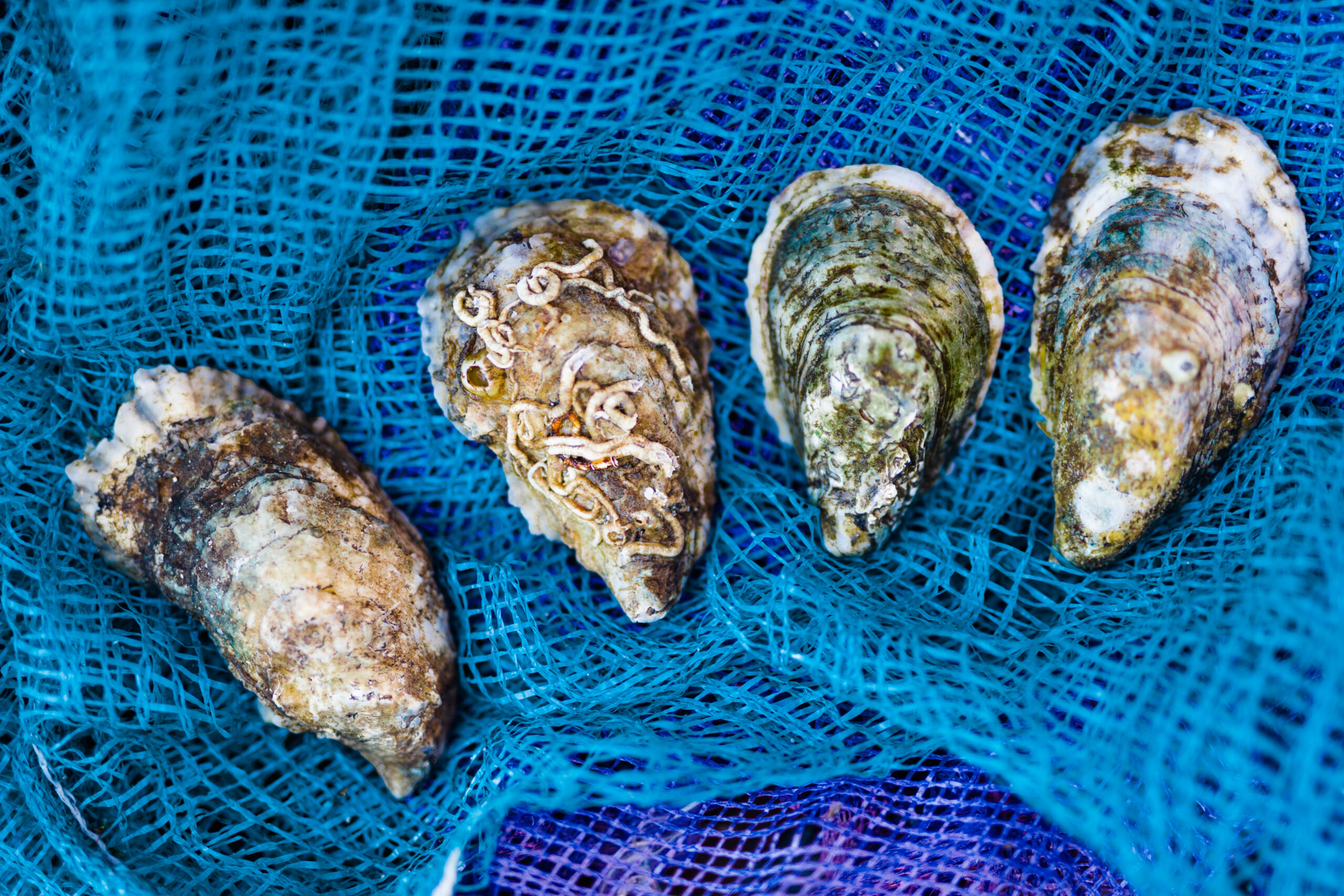Emily Woodward is the communications and project management specialist at the N.C. Coastal Reserve and National Estuarine Research Reserve. After acquiring her bachelor’s degree in English from North Carolina State University, she served at the University of North Carolina at Chapel Hill’s Institute for Marine Sciences as a communications intern and research technician. She has worked for the The Nature Conservancy’s North Carolina Chapter, where she focused on spreading awareness about water quality and migratory fish issues in the Cape Fear River.
Experienced boaters occasionally spot them in time, but even the most weathered watermen have trouble steering clear of derelict crab pots that litter waterways along North Carolina’s coast.

The N.C. Division of Marine Fisheries, or DMF, conducts an annual sweep to remove these lost or abandoned pots, but a few stragglers stay hidden, lurking beneath the surface for months or even years.
Researchers from the University of North Carolina at Chapel Hill’s Institute of Marine Sciences, or IMS, were inspired — while working on multiple oyster reef restoration projects — to make havens out of these hazards.
“En route to our research sites, we would encounter mangled crab pots covered in oysters,” says Joel Fodrie, a fisheries ecologist at IMS. “We figured, why not use this natural growth to our advantage and build some reefs?”
Fodrie, along with colleague Niels Lindquist, collaborated with commercial fishermen Adam Tyler and David “Clammerhead” Cessna to begin a broad-scale pilot study designed to test the effectiveness of using crab pots as substrate on which to build oyster reefs.
• WHY BUILD REEFS?
In the past century or so, roughly 90 percent of North Carolina’s oyster population has been wiped out by disease, pollution and loss of substrate from overharvesting, Fodrie explains.

Methods used to collect oysters often remove the substrate larval oysters need for settlement. The production of healthy reefs isn’t possible without the sturdy foundation needed to support growth.
Without reefs, coastal ecosystems can’t benefit from the services oysters provide, such as water filtration, fish habitat and shoreline stabilization. As a result, these habitats suffer.
Having fewer oysters in our estuaries is not only an environmental concern but also an economic one. Tyler, an active commercial fisherman, has personally struggled with inconsistencies in the number of oysters available for harvest each year. He notes that many fishermen no longer can rely on generating enough revenue from the oyster fishery alone.
Finding a solution to these economic and environmental problems is what led to the partnership between IMS researchers and local fishermen. Figuring out where to place the crab pots required local insight shared by Cessna and Tyler.
“I have a lifetime of experience on the water here,” says Tyler, a longtime resident of Smyrna. He’s been part of the commercial fishing world since childhood. “Based on my knowledge of the area, I know where reefs will likely flourish and where they’ll fail.”
Tackling the project as a team inspired a highly successful research design because both sides managed to bring new wisdom to the table. They were able to look at the same experiment from different perspectives.
• GETTING STARTED
The project, funded jointly by the Albemarle-Pamlico National Estuary Partnership, or APNEP, and North Carolina Sea Grant’s former Fishery Resource Grant Program, is linked to other collaborative projects with oyster-specific components.
Exploring long-term changes in accretion of natural and restored reefs, and studying the impacts of macroalgal blooms on natural and constructed reefs are just two examples of IMS/Sea Grant projects that have connections to the crab pot study. Collectively, these projects contribute to researchers’ understanding of the ecological characteristics of natural and restored reefs, and provide insight into ideal locations and methods for restoration attempts.

For this particular experiment, figuring out the ideal conditions for oyster settlement and growth meant testing various depths and ecosystem gradients, which called for hundreds of crab pots. DMF was more than willing to let IMS make a dent in their growing collection of recovered pots that could not be returned to their owners. But before placing the crab pots at the study sites, a bit of refurbishing was in order.
“One of our biggest concerns was eliminating bycatch. These pots are to avoid ghost fishing,” Tyler says.
The pots were gutted and five holes were added — four to the bottom chamber, and one to the roof of the pot — to provide easy access for crabs, fish and other organisms using the artificial habitat. Resurfacing the pots also was part of the revamping effort. Some were made with plastic-coated wire, some were made of uncoated galvanized wire, and others were dipped in cement as a way of determining whether larvae prefer one type of exterior home décor to another.
Once the pots were fully renovated they were ready for deployment.
In spring 2011, prior to the start of oyster larvae settlement, 36 crab pots were dropped at each of eight different sites along the coast of North Carolina. At each site, 12 pots were placed at one of three different depths. Two sets were deposited in intertidal zones. The last was placed in a subtidal zone, where the pots were continuously under water.
After deployment, the pots were left for a year to collect oyster spat naturally. When the team returned, they found signs of settlement and growth at all of the sites, though pots coated with cement that were placed in intertidal areas produced a higher abundance of larger, more robust oysters.
What’s more, oysters weren’t the only new crab pot tenants. Fish, such as sheepshead, pigfish and gray snapper, and crabs — stone crabs and blue crabs, for example — were living, hiding and foraging in the artificial reef.
• TIME TO FOCUS
The encouraging results from the first phase of the broad study prompted Lindquist to move forward with a more focused design of placing pots in tidal creeks, where few restoration efforts have been made.
As you move from the mouth of a tidal creek toward the upper portion, oyster abundance typically decreases. This is likely caused by lower salinities and fewer larval recruits. Larvae are transported by the tide, which makes swimming upstream a challenge because they’re going against the current.
The larvae that actually make it upstream often grow into larger adults because fewer predators and pests exist in these areas. It’s also an ideal environment for adults because oysters are less sensitive to lower salinities than many of their natural enemies.

Lindquist wanted to create a scenario where larvae could settle on pots placed at the mouths of these creeks, where salinity levels are high, and let them grow for a few months before moving them to the middle and upper parts of the creeks.
Lindquist, Tyler and Cessna placed 30 pots at the mouth where salinity and recruits were expected to be highest and five pots in the middle and upper parts of each creek. The mobile laboratories were left for six months, giving larvae time to settle. After this period, 20 of the pots from the mouth of the river were transported to mid and upper parts of the creeks.
The mobility of the crab pots allowed the team to not only provide recruits, but also establish substrate in different places in tidal creeks.
Crab pots that had been moved from the mouth were growing more oysters than pots originally placed in the mid and upper parts of the creeks. There was more settlement at the mouth. Once the pots were moved, the oysters were able to grow with limited risk of predation and less competition.
In part, the success of both studies can be attributed to the structure of the pots. Fodrie points out that because they’re three dimensional, the modified pots provide a raised platform that elevates juvenile oysters and creates a vertical refuge, making the oysters growing on them less likely to succumb to predation. Small crabs and oyster drills can’t scour as successfully when faced with climbing 18- inch walls.
He also notes that unlike natural reefs, these pots are mobile, so being able to transport them to areas where growth is likely to occur at different stages in an oyster’s life cycle makes for optimal oyster cultivation.
• SO WHAT’S THE CATCH?
However, crab pots lack aesthetic value. Oyster shell is a much more attractive substrate to build reefs with. Fodrie explains there is also a risk of losing some of the pots that have been deployed. Even though they’re built to not trap predators, the pots could get crushed and reshaped, accidentally trapping fish or crabs.
Additionally, researchers don’t want to encourage the practice of throwing debris in the water. “These pots serve an important purpose, but that doesn’t mean people should start throwing junk into the water and hoping a reef will form,” Fodrie says. “We want individual fishermen who want to increase oyster production or homeowners who are interested in building a reef under a dock to understand how and where this can work.”
Thus, an important component of this project is educating the community by communicating the findings to local fishermen, residents and agencies. This portion of the study has been accomplished through lectures, meetings and interactions with other state and local agencies. Publishing these findings and sharing information with other coastal scientists has proved beneficial as well.
• FUTURE RESTORATION
Instead of a place where crabs or fish meet their end, these refurbished pots provide fishing habitat and healthy ecosystems. But Fodrie is quick to point out that this restoration technique won’t revolutionize oyster conditions globally. “It would take millions of crab pot reef balls to recover the habitat we’ve lost. It’s just not feasible.”

However, the restorative effort can be attempted on a smaller scale. Organizations that have access to hundreds of pots could implement this project locally and create a viable habitat of restored reefs, the team suggests.
Also, some fishermen involved in the experiment offered up their shellfish leases as sites for these reefs, and requested that the crab pots be left after the conclusion of the project. They too recognized the perks of using these pots.
News of the crab pot project’s success made its way up the coast to Manteo, where the North Carolina Coastal Federation is planning to deploy 400 to 600 recycled pots in an effort to protect the shoreline around the Bodie Island Lighthouse.
Federation advocate and principal investigator for this project, Ladd Bayliss, used research results to guide the second phase of a derelict crab pot removal project that the federation is conducting. “It was helpful for us to have the crab pot work at IMS as a starting point for our project, insofar as being able to compare techniques for our reef location, as well as the formula used to coat the pots,” Bayliss says, “This is a rarely used technique for oyster and shoreline restoration so it was helpful to collaborate with Fodrie.”
This is great news for Lindquist and Fodrie, who hoped that results from the study would inspire other agencies and organizations to apply this technique, that, as they’ve proven, can be successfully executed across multiple coastal systems.
This article was published in the Winter 2015 issue of Coastwatch.
For contact information and reprint requests, visit ncseagrant.ncsu.edu/coastwatch/contact/.
- Categories:



